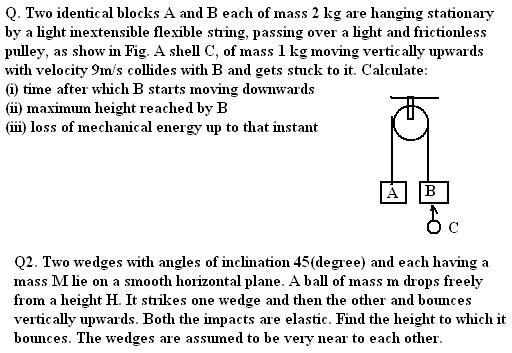1.(i)0.3s (ii) 0.46m (iii).solving....[4]
13 Answers
@ashish but i m getting these ans. i gave in #4 only.(now my keyboard is alright[1])
plz tell correct ans. n method by which u got those correct ans.
@john why wud i be posting it if i had solved it myself.. atleast post ur working ..
the answer given are 0.9s, 0.81 m and 32.4 J
btw it seems i have not forgotten LOM ,, the correct answer to that one is indeed 3 N it seems :)
ok.....if ans. to that one is 3N(probably i have forgot LOM which i never knew[3])....then plz post the solution to that one in that thread.
see the as soon as it hits block will go up with velocity 3m/s and sting goes taut ......
now it will remain taut until both th blocks move with same velocity .....
or until .................. gt = 3-gt ==> t = 3/2g ............
now after this the accn of 3kg 'complex':P will be g downwards like bfre and the other block will have accn g upwards !!!!!!!!!!!!!!!!!!!!!!!!!!!!
now the block will keep going up until the time when the accn. will bring the blocks to rest instantaneously ........................
for the third part ........ [loss of mech engy]
at that state v=0 forget KE. .......
clac the distance the (3kg)block has gone up and then the distance the (2kg)block has
cum down and see net PE of system that will be the loss / gain [dep. on +/- sign] of the system .....................
the taut condition is wat i missed whil ans. mah prev answer ... didnt cac. with this 1 see if it cums out right ...
richa ............
if J acts on 1kg mass .... -J acts on 2kg mass
J=1(v - 9)
-J = 2v ...
9-v = 2v ==> v = 3m/s
for the second problem we have ..
let the velocity on coliding be v =√2gH
as the collision is elastic the ball will bounce back horizontally (as angle 45) W.R.T wedge
so we have Vb=Vbw+Vw where Vbw is v in horizontal direction and vw=velocity of wedge after colliding (so it will be negative)
as both Vbw and Vw are horizontal the ball will move horizontally after impact
after the second impact we see that the component of bells velocity in vertical direction will be the same as calculated above (because the contribution of Vw there is along horizontal)
so the height reached is just (v+Vw)2/2g
conserving energy in first impact we can obtain vw .. so we get the answer ..
